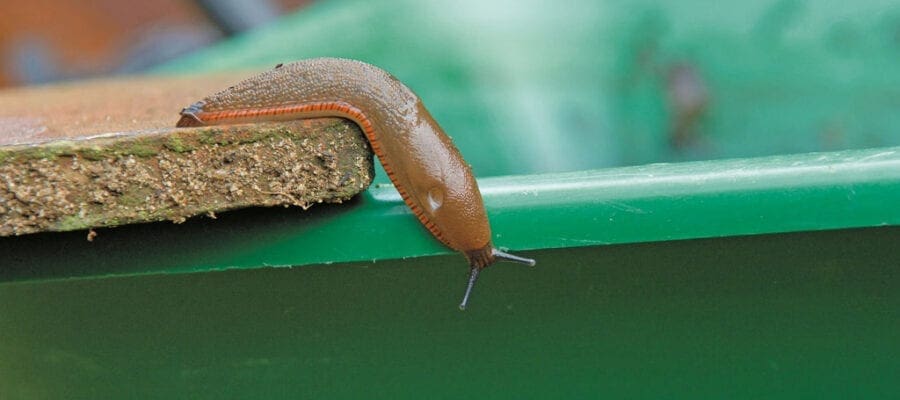
Slugs and snails
Enemy number one for most vegetable growers, slugs and snails, love damp conditions and thrive in a warm, wet summer.
- Crops affected: Virtually any crop –snails above ground, slugs both above and below soil level. Worst affected are brassicas, carrots, potatoes, seedlings.
- Symptoms: Nibbled leaves and roots can be confused with other pests such as caterpillars. Look for the tell-tale slime trails to confirm the culprit.
- Control: Most active at night, so search with a torch after dark to find the pests. Alternatively use wildlife-friendly slug pellets, traps or barriers to protect crops.
Birds
Many species are very useful in helping to rid our plots of greenfly and other pests. However a few species such as pigeons can be areal nuisance at certain times of the year.
- Crops affected: Brassicas, seedlings, onion sets (not damaged, but pulled out of the ground).
- Symptoms: Plants such as young cabbages and kale can be completely stripped of leaves, leaving only the tough stalks. The leaf margins often have pieces torn, rather than nibbled away.
- Control: Barriers are by far the most effective. Netting, fleece or pest control mesh such as Environmesh or Micromesh placed over new plantings will prevent damage. Old CDs or polythene bags suspended over the crop are at best a temporary measure.
Onion white rot
A persistent disease of onions including bulb onions and garlic. Leeks are less often infected.
- Symptoms: Plants often affected in ones and twos as the disease spreads along the rows. Plants turn yellow and become stunted and if tugged the roots may be found to have rotted. A grey white mould is often present around the base of the bulb.
- Control: Crop rotation may help, but since the disease can remain in the soil for some years is of limited value. Avoid moving contaminated soil from one part of the site to another. Grow onions in pots or raised beds if land is infected. Remove all infected material and don’t accept plants from infected gardens.

Aphids
Greenfly and blackfly are very common sap-sucking pests and can greatly reduce vigour on awide range of plants including beans, cabbages and globe artichokes.
- Symptoms: Pests congregate on shoot tips and under leaves where they suck the sap and produce sticky honeydew which attracts black sooty mould and blocks leaf pores.
- Control: Squash pests as seen with fingers or spray an organic or chemical insecticide of which there are many. Treat regularly and before pests get out of hand.
Whitefly
This pest does not cause great harm on vegetables when present in small numbers, but breeds quickly and can easily get out of hand. Very hardy and will survive outside all winter. Most troublesome on brassicas and tomatoes.
- Symptoms: Tiny white moth-like insects and associated yellow-green scales mass under the leaves. Insects make short flights on warm days or when disturbed.
- Control: Resistant to most sprays. Under glass treat with predatory wasp encarsia. Certain crops grown under cover can be treated with Provado Ultimate Bug Killer Concentrate.
Potato blight
Causes huge losses from midsummer when the air-borne spores infect the leaves of the plants. Later outdoor tomatoes are often wiped out by the same disease.
- Symptoms: Infection often shows first as blackened leaf tips or brown spots and veryquickly spreads so that whole stems collapse. The spores then move into the soil to infect the tubers which are rendered useless.
- Control: Remove stems (haulm) as soon as the symptoms appear.Regular sprays with Bayer Fruit and Vegetable Disease Control may help. Grow a resistant variety such as ‘Sarpo Axona’.Do not compost infected tubers or the diseased stems.

Carrot fly
Carrot fly is the biggest cause of problems with this crop.
- Symptoms: The surface of the root is tunnelled reducing quality and increasing waste. Diseases such as root rots often enter through the damaged tissue.
- Control: Barriers (see ‘birds’ above) are the best option and should be applied from the time of sowing and for the life of the crop. However, they only work on ground not already infested. Resistant varieties work well, especially if grown between two rows of non-resistant carrots
Club root
This disease is soil-borne and can contaminate soil for many years. Only affects the cabbage family (cabbages, cauliflowers, Brussels sprouts, kale, kohl rabi, turnips, swedes, wallflowers and related weeds).
- Symptoms: Plants become generally poor and stunted and may collapse. The roots become swollen and distorted.
- Control: As above with white rot. There are some resistant varieties such as Cabbage ‘Kilaton’ and ‘Kilaxy’, cauliflower ‘Clapton F1’ and Swede ‘Marion’.





